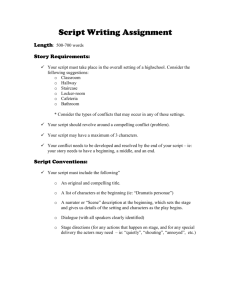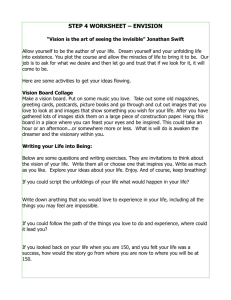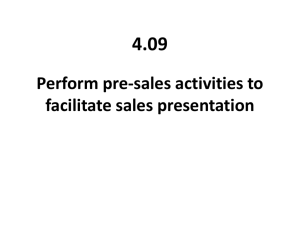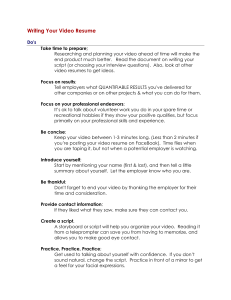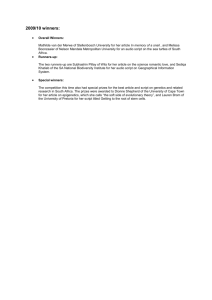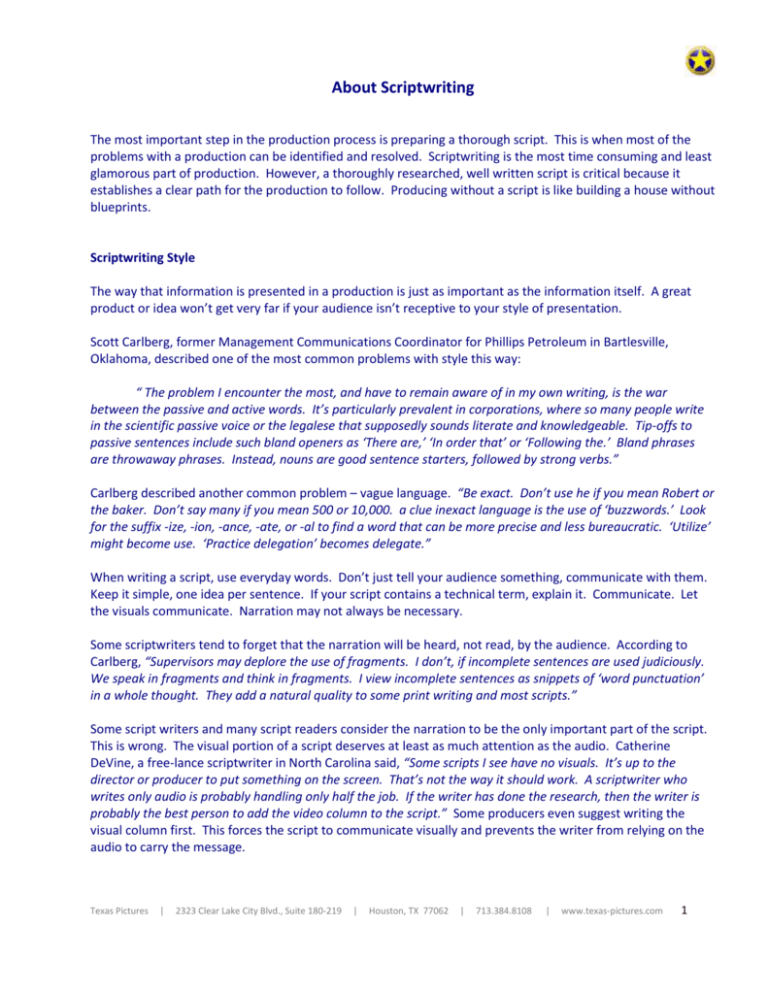
About Scriptwriting
The most important step in the production process is preparing a thorough script. This is when most of the
problems with a production can be identified and resolved. Scriptwriting is the most time consuming and least
glamorous part of production. However, a thoroughly researched, well written script is critical because it
establishes a clear path for the production to follow. Producing without a script is like building a house without
blueprints.
Scriptwriting Style
The way that information is presented in a production is just as important as the information itself. A great
product or idea won’t get very far if your audience isn’t receptive to your style of presentation.
Scott Carlberg, former Management Communications Coordinator for Phillips Petroleum in Bartlesville,
Oklahoma, described one of the most common problems with style this way:
“ The problem I encounter the most, and have to remain aware of in my own writing, is the war
between the passive and active words. It’s particularly prevalent in corporations, where so many people write
in the scientific passive voice or the legalese that supposedly sounds literate and knowledgeable. Tip-offs to
passive sentences include such bland openers as ‘There are,’ ‘In order that’ or ‘Following the.’ Bland phrases
are throwaway phrases. Instead, nouns are good sentence starters, followed by strong verbs.”
Carlberg described another common problem – vague language. “Be exact. Don’t use he if you mean Robert or
the baker. Don’t say many if you mean 500 or 10,000. a clue inexact language is the use of ‘buzzwords.’ Look
for the suffix -ize, -ion, -ance, -ate, or -al to find a word that can be more precise and less bureaucratic. ‘Utilize’
might become use. ‘Practice delegation’ becomes delegate.”
When writing a script, use everyday words. Don’t just tell your audience something, communicate with them.
Keep it simple, one idea per sentence. If your script contains a technical term, explain it. Communicate. Let
the visuals communicate. Narration may not always be necessary.
Some scriptwriters tend to forget that the narration will be heard, not read, by the audience. According to
Carlberg, “Supervisors may deplore the use of fragments. I don’t, if incomplete sentences are used judiciously.
We speak in fragments and think in fragments. I view incomplete sentences as snippets of ‘word punctuation’
in a whole thought. They add a natural quality to some print writing and most scripts.”
Some script writers and many script readers consider the narration to be the only important part of the script.
This is wrong. The visual portion of a script deserves at least as much attention as the audio. Catherine
DeVine, a free-lance scriptwriter in North Carolina said, “Some scripts I see have no visuals. It’s up to the
director or producer to put something on the screen. That’s not the way it should work. A scriptwriter who
writes only audio is probably handling only half the job. If the writer has done the research, then the writer is
probably the best person to add the video column to the script.” Some producers even suggest writing the
visual column first. This forces the script to communicate visually and prevents the writer from relying on the
audio to carry the message.
Texas Pictures
|
2323 Clear Lake City Blvd., Suite 180-219
|
Houston, TX 77062
|
713.384.8108
|
www.texas-pictures.com
1
Preparation Steps
1. Consider your audience. Decide on the type of presentation that your audience would be most receptive
to: technical, general, or somewhere in between. What will they want to see?
2. Outline the key points of the topic. Make a list of the most important points to be covered and arrange
them in the order they should be presented. As a rule, any presentation should open with a very strong
point because this is when the viewer is most receptive. Close the script with a point that has similar
impact because it is the closing moments of a presentation that are most remembered by the viewer.
3. Watch some television. Select several TV shows that were produced from a script and watch how the
camera is used and why. Note the frequency and conditions in which camera movements; such as pans,
tilts and zooms are used. Zooms are sort of a way to create movement, but zooms can quickly become
monotonous and amateurish looking. Also note the number of shots used in short segment of the
broadcast. Usually, there are at least 10 shot changes in any one-minute of a production. Remember that
your audience is accustomed to and most receptive to this style of production.
Writing Guidelines
1. Remember your audience. Present information the way your audience would like to see it. If you don’t
capture and keep the viewer’s attention, the production is worthless.
2. Think visually. With each scene ask, “What are we doing here to maintain viewer interest?”
3. The 7-second rule. Avoid having static shots in your production that last longer than 7 seconds whenever
possible. The viewer will quit watching if he or she isn’t seeing anything new. Using motion within the
frame, or cut to another shot to keep the viewer interested.
4. Avoid the PowerPoint format. Resist writing in a style that divides the video into one point, one shot.
Think more in terms of one sentence, one shot. Use subjects with movement whenever possible.
5. Keep the script well organized. video descriptions should always be parallel to accompanying audio. This
makes the script easier to understand and visualize.
6. Consult with others involved in the production. Consulting with the director and others can also help to
improve the “polish” of the production.
7. Keep graphics simple and concise. Graphics with relatively small details become illegible when compressed
for CD-ROM or the web. Additionally, graphics are often interpreted by audiences as filler and tend to
reduce the overall effectiveness of the production.
8. Be brief. The longer a presentation is, the more likely losing viewer interest becomes.
Review
A first draft of a script often undergoes a pretty gruesome review process. The document is usually circulated
via email among supervisors, executives, content experts and others, and can return with extensive and even
contradictory revisions. This can lead to delays in production and can reduce the effectiveness of the finished
program. The ideal way to review a script is to hold a meeting with all of the key people involved in the
approval process. The writer guides the others through the script by reading the narration out loud and
describing the visuals and other audio for each scene. This forces visual thinking and leads to a more thorough
review that yields more constructive input, better revisions, and establishes a sense of ownership among the
attendees.
© Copyright 2007, Texas Pictures. All rights reserved
Texas Pictures
|
2323 Clear Lake City Blvd., Suite 180-219
|
Houston, TX 77062
|
713.384.8108
|
www.texas-pictures.com
2
Instructions
On the following page is a blank table in script format. The rows number themselves automatically, so you can
insert or delete rows as the project requires by selecting a row or rows then right-clicking within the selection
and clicking on “insert rows or “delete rows”. You can also move rows by dragging
The Video column is for descriptions of visuals (duh) and should include camera directions, transition
descriptions and anything else visually important. You can also insert graphics to better illustrate or storyboard
the script.
The Audio column is for narration, and music and audio f/x descriptions and direction. The narration should be
clearly distinguished from the audio notes (usually the narration in each scene begins with NARR: and the
other audio notes are in parentheses or italics, or a different color). The point is to make the narration easy
enough to spot that the narration can be read without requiring the reader to search through confusing text.
The Audio column is also set to 1.5 spacing – this leaves room for notes.
Save this document under a new name and delete these first three pages to create a script using our template.
Texas Pictures
|
2323 Clear Lake City Blvd., Suite 180-219
|
Houston, TX 77062
|
713.384.8108
|
www.texas-pictures.com
3
Video Title
video script
date
VIDEO
NARRATION
1.
2.
3.
4.
5.
6.
7.
8.
9.
10.
11.
12.
13.
14.
15.
16.
17.
18.
19.
20.
21.
22.
23.
24.
25.
26.
27.
28.
Texas Pictures
|
2323 Clear Lake City Blvd., Suite 180-219
|
Houston, TX 77062
|
713.384.8108
|
www.texas-pictures.com
4
VIDEO
NARRATION
29.
30.
Texas Pictures
|
2323 Clear Lake City Blvd., Suite 180-219
|
Houston, TX 77062
|
713.384.8108
|
www.texas-pictures.com
5


